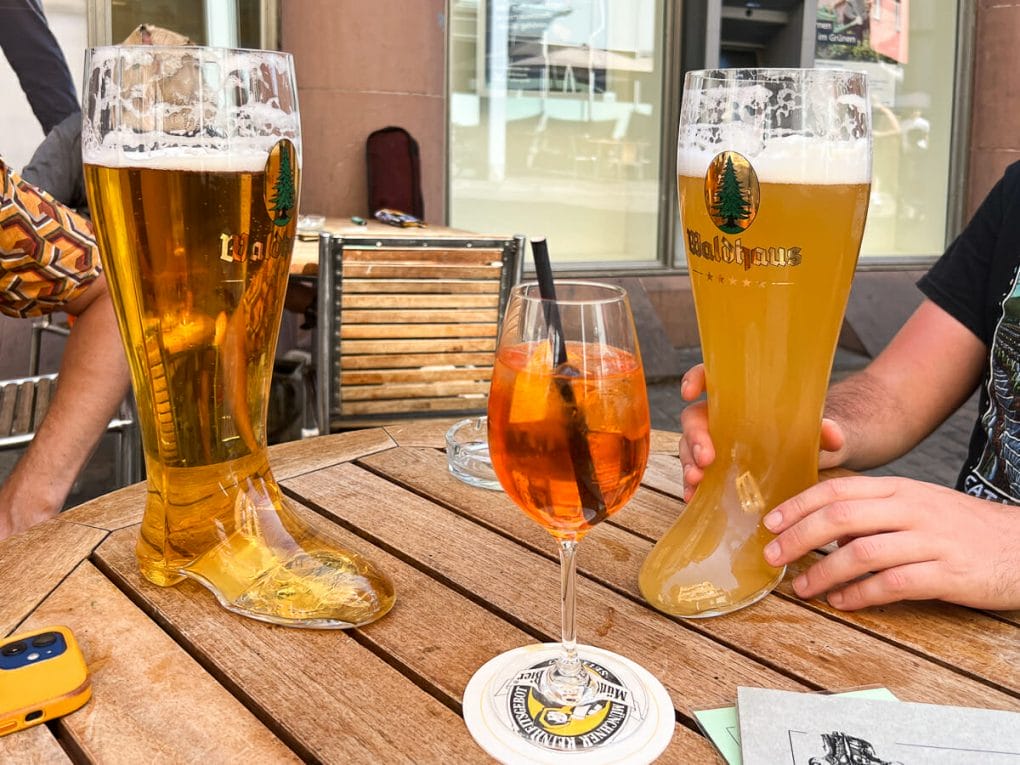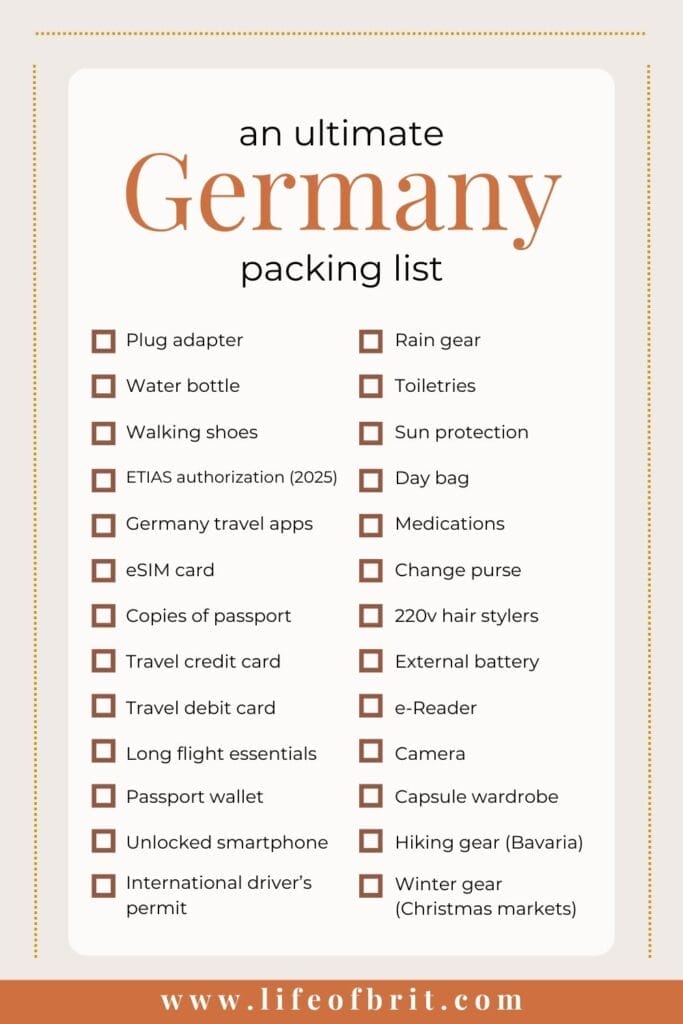This ultimate Germany packing list shares everything you need to bring with you when visiting or moving to Germany.
After calling Germany home for a few years, I’ve become well acquainted with what’s available and what I’ve missed from home. Although you can find anything you may need or want here, some things are just necessary to pack!
And although Germany is essentially the same as anywhere else, there are some things to keep in mind unique to visiting Germany, which I share here.
So, whether you’re packing for a trip or a move to Germany, here are the essentials I recommend adding to your packing list!
Read more: When is the Worst Time to Visit Germany?
This post contains affiliate links. As an Amazon Associate I earn from qualifying purchases if you click my links and make a purchase, at no cost to you. Learn more on my disclosure page. Thank you for your support!

5 Quick Tips When Packing for Germany
Before we get into the meat of what to include on your Germany packing list, here are some essential things to remember.
1. Traveling with a Backpack vs Suitcase in Germany
Traveling with a backpack or a suitcase around Europe is an age-old debate! But here’s what I recommend bringing, depending on your travel preferences and plans.
Traveling with a backpack in Germany is best for those who pack light, plan to move around to many places, and will take national trains and buses. A backpack is easier to haul over cobblestone streets and store on public transportation.
Traveling with a suitcase in Germany is best for those who like to pack all their creature comforts and plan to shop in Germany (you’ll want the hard side for any wine, beer, and fragile souvenirs). A suitcase is also a good option for those who won’t have to worry about hauling their bag from place to place because of a more relaxed itinerary or a budget for taxis.
Read more: Best Front Loading Backpacks for Travelers

2. How to Dress in Germany
You don’t need to worry so much about changing your style to blend in with the locals. And compared to other European countries, I find Germans dress a bit more casually and often sport nice jeans and a tasteful T-shirt or top.
Although sweats aren’t all that common, I’ll also sometimes see people sporting high-end athleisure like matching sets and fitted joggers.
What to wear in Germany: leave the ratty gym shorts, tees, and sweats at home and opt for casual or smart casual outfits like jeans, shirts, sweaters, day dresses, etc.

3. Don’t Overpack & Save Room for Souvenirs
There are a lot of cool souvenirs from Germany that you’ll likely want to bring home with you! So I recommend coming with room in your suitcase or backpack.
You’ll also want to avoid overpacking, as it’s a pain hauling around a heavy suitcase or backpack for those with a busy itinerary.

4. What Not to Bring to Germany
Curious about what not to bring to Germany?
Here are a few things to leave at home because they’re either illegal or unnecessary:
- Large quantities of cash: Safer and better off getting money from a local ATM with your debit card
- 110v hair stylers: Not compatible with Germany’s 220v outlets without a converter
- Checks or traveler’s checks: Not accepted in many places anymore
- Clothing with offensive language, symbols, or hate speech: Frowned upon and at times illegal depending on what’s shown (should be common sense)
- Pocket knives exceeding 12 cm (4.75 in): Illegal
Another thing I will say is not completely necessary to pack for Germany, is a hidden money belt or a hidden neck wallet. Germany is a very safe destination and compared to many other European countries (like France, Spain, and Italy), pickpockets aren’t as much of a problem or as prominent.
However, if it’ll give you peace of mind, then I say go for it! I just wanted to call out that I’ve traveled extensively around Europe and have never needed the hidden wallets myself.

5. Packing for a move to Germany?
If you’re packing to move to Germany, this list is still a great resource!
However, I recommend bringing some additional things only because they’re not always readily available here or they’re items that are probably slightly different from what you’re used to at home.
What to pack when moving to Germany:
- Favorite snacks from home: for my fellow Americans, I mean things like American-style peanut butter, mac n cheese, hot sauce, salsa, etc.
- Favorite deodorant and toothpaste
- Favorite cold meds and OTC meds like Advil, Tylenol, Sudafed, NyQuil
- Supply of prescription drugs if it’s something difficult to get prescribed in Germany
- Favorite feminine products: tampons usually don’t have the plastic applicator in Europe
Read more: Most Beautiful Small Towns in Germany

25 Items that Should Be On Your Germany Packing List
Without further ado, here are the essentials that should be on your packing list for Germany!
1. EU Electronic Visa
At the moment, Americans and many citizens of other nations do not need a tourist visa to enter the EU or Germany. However, beginning 2025, US citizens must apply for an ETIAS, an electronic visa waiver that allows entry to the European Union.
Keep your eyes peeled for when you’ll need to register for the EU’s new e-visa!

2. A travel-friendly credit card
Credit cards are a safe and convenient way to pay for your travels in Germany. Most places accept American Visa and Mastercard credit cards, but American Express and Discover are not often taken.
I recommend coming with a travel credit card. I love my Chase Sapphire Preferred credit card because it has 0 foreign transaction fees, minimal travel insurance included like lost luggage reimbursement, and I earn great travel rewards just for using it.
When paying with a credit card, always choose to pay in the local currency when asked. This way, your bank sets the exchange rate instead of the merchant, which is bound to be better for you.
Read more: 50+ Must-Pack Travel Essentials for Women

3. A travel-friendly debit card
A debit card in Germany is essential for taking out cash and making financially responsible purchases.
That’s because the best and most affordable way to get Euros is by taking out cash at a local ATM, NOT exchange places at the airport or in town. This way you don’t have to worry about carrying around tons of cash that can get lost or stolen, and you’ll get the best rate.
I love my Charles Schwab Investor Checking debit card for traveling because it has 0 foreign transaction fees, includes monthly reimbursement on ATM fees, and 24-hour international customer support should any issues arise.

4. Copies of passport and important docs
Keeping copies or photos of your important travel docs on hand is essential in case you lose or damage anything vital. If you need an emergency passport from the local US embassy, having proof of these documents and your personal ID numbers handy can help make the process smooth and quick.

5. International drivers license
If you plan to drive in Germany, you need an IDP or international driver’s license. You can get an IDP from AAA by applying in person at your nearest AAA branch, which typically only takes 20-30 minutes, or by mail.
The fee is $20, and you’ll need to submit two passport photos, proof of a valid driver’s license, and a completed application form.

6. Unlocked smartphone & eSIM
Getting a SIM card in Germany is an easy and convenient way to stay connected while traveling. You’ll need to have an unlocked smartphone, and you can find them for sale at local Vodafone phone shops, where you can nab prepaid cards or an actual plan for long-term stays. You must register with your passport in Germany when purchasing a local SIM card.
You can also get an eSIM card with apps like Airalo. An eSIM only works in newer, unlocked smartphones but allows you to access local data without installing a physical card into your phone. Adding more data to your plan is also easier if you run out and don’t need to bother registering. However, with an eSIM, you won’t have a phone number and won’t be able to make phone calls unless they’re over data.
Get $3 off your first eSIM data pack from Airalo with my handy Airalo referral link (and I’ll get $3, too!).

7. Essential Travel Apps
Coming with the best apps for Germany already downloaded on your phone is a convenient way to get around and experience Deutschland.
Some of the best German apps are:
- DB Navigator: National and regional train travel
- FreeNow: Germany’s preferred taxi app
- Google Translate: for easy translation between German and English
- Lieferando: Germany’s food delivery app for those lazy hotel nights

8. Classic travel gear
I won’t spend too much time harping on the classic European travel essentials I recommend! But here are my favorite general travel items that I recommend for any trip:
- Packing cubes: a must for compact and organized packing in your luggage
- Toiletry bag: a hanging bag makes it easy to keep your toiletries organized and handy in the bathroom.
- Toiletry bottles: reusable, TSA approved bottles for carrying your favorite toiletries.
- Dirty laundry bag: a must for keeping your dirty clothes separate from clean, and for any necessary laundry trips while traveling.
- Apple AirTag 4 Pack: an essential for keeping track of your valuables and bags.
Read more: Best Long Haul Flight Essentials for Your Carry On

9. Passport wallet
A passport wallet is essential for travel in Germany to ensure you keep your passport safe and readily available. Especially if you plan to travel across German borders, where the police often stop cars or trains to check for entry stamps and valid documents more often than in other EU nations.

10. Comfy walking shoes
When you’re traveling in Germany, you’re going to walk a lot. Like 15,000-20,000+ steps a day, a lot! Coming with your favorite comfortable walking shoes is a must.
Besides your go-to tennis shoes, I recommend Birkenstocks for comfy walking sandals, which, fun fact, are German-made! They form to your feet and offer great cushion and open toes for those long, hot summer days.
I also recommend getting cushioned insoles to put into your cute shoes if you don’t want to have to wear running or walking shoes everywhere. I like these sole insert by Dr. Scholl’s that I use in my Nike or Adidas sneakers.

11. Water bottle
In Germany, water is safe to drink, and public water fountains are hard to come by! Plus, restaurants in Germany don’t offer free tap water, and the bottles you can buy are either too tiny for American thirst or literally one liter big.
I have quite a few gripes on water culture in Germany, if you couldn’t tell!
Having a reusable water bottle with you in Germany means you can stay hydrated without wasting money on disposable plastic bottles and always have water on hand without having to hunt for a store. It’s also better for the environment!
I never go anywhere without my 32oz Hydro Flask, which I feel is big enough to last me a bit without being too bulky that it’s annoying to carry around.
For something more space saving, this collapsible water bottle is another great pick.

12. Plug adapter
Outlets in Germany are Type C, which are two round pegs. Visitors should bring a couple adapters for charging tech essentials.
A universal adapter is also handy for travels across Europe as some countries use a different plug (like the UK, Italy, and Switzerland).

13. Rain gear
Germany can be rainy, so having rain gear on hand is a must!! Especially if your travels are planned in the spring and fall when rainfall tends to be at its peak.
I love this compact umbrella because it fits nicely in my purse, my day pack’s side pocket, or even my jacket pocket.
Quality rain proof boots and a nice rain jacket are also a must!

14. Toiletries
Obviously you can’t go to Germany without essential toiletries! Here are the classic items you should have on your packing list for Germany:
- Travel Toothbrush and travel toothpaste
- Deodorant
- Skincare: face wash, treatment, moisturizer
- Sunscreen
- Makeup favorites
- Body wash or solid bar of soap
- Solid shampoo and conditioner
- Hand sanitizer
- Lip balm
You can get anything you may need while in Germany, but some things are slightly different, like feminine hygiene products, deodorant, and toothpaste.
If you’re a skincare enthusiast, save room in your luggage for European skincare items that are cheaper or more easily found in Germany! Brands like La Roche Posay, Bioderma, and Uriage are especially good picks to get while you’re here.

15. Sun protection
Although it can be gloomy in Germany, I recommend packing sun protection. I’m big on facial sunscreen and polarized sunglasses to protect my eyes and skin from cancer and damage. Or a hat if that’s more your thing!
My favorite sun protection items lately have been my affordable, polarized Sunskis, my Innisfree facial sunscreen, and my basic dad hat.

16. Day bag
No trip to Germany is complete without a quality day bag where you can carry your must-have day travel essentials.
I travel with my Fjallraven Kanken, a cute and compact backpack with a laptop sleeve that can double as a daypack for hiking. But this laptop backpack by Lenovo is another great pick.
A packable backpack that folds down into a handy carrying case is also a great option for travel around Europe!
I also frequently carry around a crossbody fanny pack because of how convenient, lightweight, easy to access, and secure it is.

24. Medications
You can find OTC meds you may need in most pharmacies in Germany should anything come up. But I recommend bringing along your favorite basics to have handy because some options are different in Germany than at home.
Medicines to pack for Germany travel include:
- OTC pain relievers like Advil and Tylenol
- Cold medicine like Sudafed or NyQuil (cold medicine is not as good in Germany)
- Cough drops for long flights
- Liquid IV for jetlag and hydration
- EmergenC for boosted immune system while traveling

17. Change purse
A change purse may be a weird recommendation for your Germany packing list, but hear me out! In Germany, you’ll use cash frequently, which means you’re sure to accumulate a lot of change and €1 or €2 coins.
These coins can get heavy and annoying when floating everywhere in your bags or pockets. Plus, you’ll want to have coins handy to pay for things like public bathrooms, tips, parking, coffee (which are cheap), and more.

18. 220v hair stylers
American hair stylers like dryers, curlers, and straighteners aren’t compatible with the voltage used in Germany and may short circuit or literally burn out.
Packing dual voltage, travel-sized hair stylers are the way to go when traveling to Germany. Most 3+ star hotels should have a hair dryer to save you on packing.
Here are some 220V travel stylers to pack with you:
- Conair Travel Hair Dryer: a compact and foldable hair dryer with two heat settings that’s cheap and gets the job done
- FURIDEN Lite Small Size Travel Curling Iron also doubles as a straightener and can be used at home and abroad.

19. External Battery
An external battery is essential to stay charged, safe, and connected when out and about, so you aren’t caught out without a way to call or navigate when needed.
And with how many pictures I take, my phone battery gets run down pretty quickly!
Some recommended portable batteries:
- The Anker Portable Charger is a top-rated portable charger that tops the charts as one of the best quality, durable, and long-lasting.
- I recently purchased the Zendure SuperMini 20W per a New York Times Recommendation, and I love how compact it is and that it can charge my phone nearly two times.
- Omnicharge Omni 20+ 20000mah Power Bank is a powerful charging bank that packs a punch! This thick charger lets you charge your phone and larger devices like laptops.

20. E-Reader
I love having my Kindle when I travel around Germany. It’s a way to stay entertained while traveling on a train or in the car, and even something to do in your downtime in your hotel.
Some of the best E-readers are:
- Kindle Paperwhite: I love my Kindle. It’s compact and lightweight, doesn’t need to be charged often, holds hundreds of books, and the new models are waterproof.
- iPad mini or SAMSUNG Galaxy Tab: for a tablet that can do more than act as an e-reader.

21. Camera
Even though I predominantly take photos on my iPhone, I love traveling with my Olympus Mirrorless Camera and Instax Mini.
The Olympus allows me to take high-quality, raw photos that I can edit in greater detail (and also I love its retro look). And the Instax mini is for funsies! It’s also a great way to share memories with new and old friends on your travels.

22. Clothing to pack
There’s nothing you need to worry about packing for Germany clothing-wise. You’re able to wear what you usually wear at home!
But I always pack items on long trips that are comfortable for walking around and suitable for the weather. I also pack interchangeable options and one lovely outfit for special events or plans.

23. Hiking Clothes
Depending on your travel plans and where you’re going, you may need to pack some hiking clothes! Hiking in Germany is an exciting thing to do for those visiting beautiful regions such as Bavaria, the Mosel Valley, and the Elbe Sandstone Mountains.
Some hiking gear to bring:
- Hiking boots or shoes
- Athletic pants
- Athletic tops

25. Winter gear
Winter in Germany can get quite chilly (below freezing), so packing winter gear like hats, gloves, and a scarf will ensure you stay warm while exploring!
If you’re planning on visiting Germany during the Christmas market season, you’ll want the warm stuff to stay cozy while standing outside for hours!
There you have it, my ultimate Germany packing list! Share your questions or recommendations for what to pack for Germany below!



